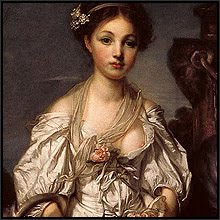Eighteenth century German artist Johann Jakob Haid is perhaps not among the more iconic names in art, but during his lifetime he secured a reputation for himself as a portrait and botanical artist, portraying both his fellow artists and noted scientists of the day, and producing other commissioned portraits (below), as well as illustrating a number of botanical books. But the work from his hand which seems the most to have endured is ironically a still life whose subject is transience.


Haid’s mezzotint Alles ist Eitel ('All is Vanity', below) belongs to the durable tradition in art known as Vanitas (‘Vanity’), in which the chosen items in a still life arrangement serve to portray the ephemeral nature of existence. Human vanity is folly, says this tradition, for all things must pass.

The artist's image offers us a still life of perishables: the candle’s flame will be extinguished, the fragile soap bubbles will burst, the blooms will wilt and fade – even the ruin on the vase’s decoration hints at the passing of empires. The hourglass suggests the rush of time, and the human skull – the key element in any vanitas picture – reminds us of our own mortality. The still life which fills the lower half of Haid's frame is in stark and dramatic contrast to the dark and empty upper half of the image, whose impenetrable shadows hint at the unknown which waits beyond life itself.

In contrast to the confidently-painted skull in the vanitas still life by Pieter Claes of a century before Haid (above), an uncertainty in the anatomical details of the skull suggests that the artist might have used a medical illustration for his reference, rather than having the actual object in front of him to study. But with the flowers, Haid clearly is on familiar ground, and the knowledge gained from his botanical illustrations manifests itself in the details of every petal, and in the veins of every leaf.

Intriguingly, the highlights on the soap bubbles are in the form of both a star and a cross (detail above). In including these distinct details, did Haid wish to hint at some further meaning? It is difficult to know. And what of the writing materials and the two books? The artist seems to suggest that even an imagined path to immortality through creating works which endure beyond our own lifetimes is also folly, for the books remain shut, and the scroll is left unwritten.
So is all vanity? The flowers which Haid portrayed in such meticulous detail so far have survived two and a half centuries beyond their real-life counterparts, and the soap bubbles with their mysterious details drift on through the air.

Artist: Johann Jakob Haid
Work: Alles ist Eitel, c. 1750
Medium: Mezzotint
Location: New York Public Library


Haid’s mezzotint Alles ist Eitel ('All is Vanity', below) belongs to the durable tradition in art known as Vanitas (‘Vanity’), in which the chosen items in a still life arrangement serve to portray the ephemeral nature of existence. Human vanity is folly, says this tradition, for all things must pass.

The artist's image offers us a still life of perishables: the candle’s flame will be extinguished, the fragile soap bubbles will burst, the blooms will wilt and fade – even the ruin on the vase’s decoration hints at the passing of empires. The hourglass suggests the rush of time, and the human skull – the key element in any vanitas picture – reminds us of our own mortality. The still life which fills the lower half of Haid's frame is in stark and dramatic contrast to the dark and empty upper half of the image, whose impenetrable shadows hint at the unknown which waits beyond life itself.

In contrast to the confidently-painted skull in the vanitas still life by Pieter Claes of a century before Haid (above), an uncertainty in the anatomical details of the skull suggests that the artist might have used a medical illustration for his reference, rather than having the actual object in front of him to study. But with the flowers, Haid clearly is on familiar ground, and the knowledge gained from his botanical illustrations manifests itself in the details of every petal, and in the veins of every leaf.

Intriguingly, the highlights on the soap bubbles are in the form of both a star and a cross (detail above). In including these distinct details, did Haid wish to hint at some further meaning? It is difficult to know. And what of the writing materials and the two books? The artist seems to suggest that even an imagined path to immortality through creating works which endure beyond our own lifetimes is also folly, for the books remain shut, and the scroll is left unwritten.
So is all vanity? The flowers which Haid portrayed in such meticulous detail so far have survived two and a half centuries beyond their real-life counterparts, and the soap bubbles with their mysterious details drift on through the air.

Artist: Johann Jakob Haid
Work: Alles ist Eitel, c. 1750
Medium: Mezzotint
Location: New York Public Library



































No comments:
Post a Comment
You are welcome to share your thoughts..